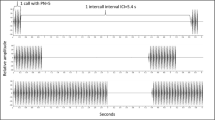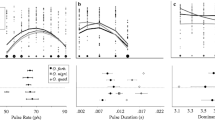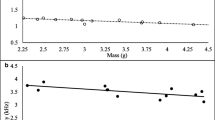Summary
In this study, we combine both field and laboratory experiments to address the effects of female preference for certain call characteristics on a large-male mating advantage in the treefrog H. chrysoscelis. In laboratory-choice experiments, females always chose the call with the lower fundamental frequency when call rate and call intensity were held constant and the difference in frequency between the two calls was 15%. The lower frequency call was preferred by 8 out of 12 females when the difference in fundamental frequency was 7.4%. These results are consistent with field comparisons of the size of unmated males calling within 2 m of a mated male: Male body size was negatively correlated with fundamental frequency and the greater the size difference, the more likely that the larger male mated. In field choice experiments, females preferred males with higher call rates. Since size differences between males used in this experiment averaged only 2.3 mm, we would not expect the fundamental frequency of a male's call to be the best predictor of mating success. Laboratory results demonstrated that call rate could override female preference for the ‘low frequency’ call over the ‘high frequency’ call, while intensity could at least dilute this preference. However, individual males in the field varied both call rate and the call intensity as perceived by the female. We suggest that the interaction between call rate, male size and mating success should be studied further through the use of field-choice experiments.
Similar content being viewed by others
References
Arak A (1983) Sexual selection by male-male competition in natterjack toad choruses. Nat (London) 306:261–262
Blair WF (1964) Isolating mechanisms and interspecies interactions in anuran amphibians. O Rev Biol 39:334–344
Blair WF, Littlejohn MJ (1959) Stage of speciation in two allopatric populations of chorus frogs Pseudacris. Evolution 14:82–87
Bogert CM (1960) The influence of sound on the behavior of amphibians and reptiles. In: Langyon WE, Tavolga WN (eds) Animal sounds and communication. AIBS Publ 7:137–320
Fellers GM (1979) Aggression, tertitoriality and mating behavior in North American treefrogs. Anim Behav 27:107–119
Forester DM, Czarnowsky R (1985) Sexual selection in the spring peeper, Hyla crucifer (Amphibia, Anura): role of the advertisement call. Behaviour 92:112–128
Gerhardt HC (1988) Acoustic properties used in call recognition by frogs and toads. Chapter 21. In: Fritzsch B (ed) Amphibian auditory system, chap 21. Wiley, New York, pp 455–483
Gerhardt HC, Daniel RE, Perrill SA, Schramm S (1987) Mating behaviour and success in the green treefrog. Anim Behav 35:1479–1489
Howard RD (1978) The evolution of mating strategies in bullfrogs, Rana catesbeiana. Evolution 32:850–871
Morris MR (1989) Female choice and selection for large males in the treefrog Hyla chrysoscelis. Behav Ecol Sociobiol (in press)
Perrill SA, Gerhardt HC, Daniels R (1987) Sexual parasitism in the green treefrog (Hyla cinerea). Science 200:1179–1180
Ryan MJ (1980) Female mate choice in a Neotropical frog. Science 209:523–525
Ryan MJ (1983) Sexual selection and communication in a neotropical frog, Physalaemus pustulosus. Evolution 37:261–272
Ryan MJ (1985) The tungara frog: A study in sexual selection and communication. The University of Chicago Press, Chicago
Robertson JGM (1986) Female choice, male strategies and the role of vocalizations in the Australian frog Uperoleia rugosa. Anim Behav 34:773–784
Sokal RR, Rohlf FJ (1981) Biometry, 2nd edn. Freeman, San Francisco
Staughan IR (1975) An analysis of the mechanisms of mating call discrimination in the frogs Hyla regilla and H. cadaverina. Copeia 1975:415–424
Sullivan BK (1983) Sexual selection in Woodhouse's toad (Bufo woodhousei) II. Female choice. Anim Behav 31:1011–1017
Wilbur HM, Rubenstein DI, Fairchild L (1978) Sexual selection in toads: the roles of female choice and male body size. Evolution 32:264–270
Zelick RD, Narins PN (1983) Intensity discrimination and the precision of call timing in two species of neotropical treefrogs. J Comp Physiol A 153:403–412
Author information
Authors and Affiliations
Rights and permissions
About this article
Cite this article
Morris, M.R., Yoon, S.L. A mechanism for female choice of large males in the treefrog Hyla chrysoscelis . Behav Ecol Sociobiol 25, 65–71 (1989). https://doi.org/10.1007/BF00299712
Received:
Accepted:
Issue Date:
DOI: https://doi.org/10.1007/BF00299712




